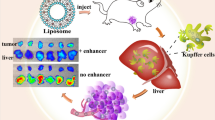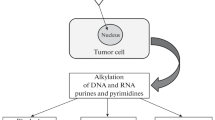Abstract
The tumoricidal effects of etoposide incorporated into lipid nanoparticles after single-dose administration were investigated in Dalton's lymphoma ascites bearing mice. Etoposide and its nanoparticle formulations were administered intraperitoneally, and the cell cycle perturbation, cytogenetic damage, cell death (apoptosis), tumor regression, and animal survival were investigated as parameters of response with time. The tumor burden of mice treated with etoposide and its nanoparticle formulations decreased significantly (P<.001) compared with the initial up to 4 to 6 days, followed by an increase at later time intervals. Of the 3 different formulations, the survival time of mice was higher when treated with etoposide-loaded tripalmitin (ETP) nanoparticles, followed by etoposide-loaded glycerol monostearate (EGMS) (27.3%) and etoposide-loaded glycerol distearate (EGDS) (27.3%) compared with free etoposide. Cell cycle analysis revealed the hypodiploid peak (sub G0/G1 cell population) as well as G2 arrest in mice treated with etoposide and its nanoparticle formulations. The frequency of dead cells treated with the nanoparticle formulations remained high even after 8 days of treatment compared with free etoposide. The mice treated with nanoparticle formulations exhibited hypodiploid peaks and reduced S phase even 8 days after treatment, whereas the free etoposide-treated mice showed decrease in apoptosis after 3 days of treatment. The apoptotic frequency in cells 17 days after treatment was in the order of ETP>EGMS>EGDS> etoposide. The experimental results indicated that among the 3 nanoparticle formulations studied, the ETP nanoparticles showed greater and prolonged apoptotic induction properties, resulting in the higher increase in survival time of tumor bearing mice.
Similar content being viewed by others
References
Sadzuka Y, Hirota S, Sonobe T. Intraperitoneal administration of doxorubicin encapsulating liposomes against peritoneal dissemination.Toxicol Lett. 2000;116:51–59.
Koga S, Hamazoe R, Maeta M, et al. Prophylactic therapy for peritoneal recurrence of gastric cancer by continuous hyperthermic peritoneal perfusion with mitomycin C.Cancer. 1988;61:232–237.
Fujimura T, Yonemura Y, Muraoka K, et al. Continuous hyperthermic peritoneal perfusion for the prevention of peritoneal recurrence of gastric cancer: randomized controlled study.World J Surg. 1994;18:150–155.
Tamura T, Fujita F, Tanimoto M, et al. Anti-tumor effect of intraperitoneal administration of cisplatin-loaded microspheres to human tumor xenografted nude mice.J Control Release. 2002;80:295–307.
Muller RH, Olbrich C. Solid lipid nanoparticles: phagocytic uptake, in vitro cytotoxicity and in vitro biodegradation.Drugs Made Ger. 1999;42:49–53.
Mehnert W, Mader K. Solid lipid nanoparticles production, characterization and applications.Adv Drug Deliv Rev. 2001;47:165–196.
Muller RH, Mehnert W, Lucks JS, et al. Solid lipid nanoparticles (SLN)-an alternative colloidal drug carrier system for controlled drug delivery.Eur J Pharm Biopharm. 1995;41:62–69.
Schwarz C, Mehnert W, Lucks JS, Muller RH. Solid lipid nanoparticles (SLN) for controlled drug delivery. I. Production, characterization and sterilization.J Control Release. 1994;30:83–96.
Schwarz C, Mehnert W. Solid lipid nanoparticles (SLN) for controlled drug delivery. II. Drug incorporation and physicochemical characterization.J Microencapsul. 1999;16:205–213.
Schwarz C, Mehnert W. Freeze-drying of drug-free and drug-loaded nanoparticles.Int J Pharm. 1997;157:171–179.
Freitas C, Muller RH. Effect of light and temperature on zeta potential and physical stability in solid lipid nanoparticle (SLN) dispersions.Int J Pharm. 1998;168:221–229.
Dollery C. Etoposide. In: Dollery C, ed.Therapeutic Drugs. London, UK: Churchill Livingstone; 1999:E103-E108.
Chamberlain M. Recurrent brainstem gliomas treated with oral VP-16.J Neurooncol. 1993;15:133–139.
Ashley D, Meier L, Kerby T, et al. Response of recurrent medulloblastoma to low-dose oral etoposide.J Clin Oncol. 1996;14:1922–1927.
Freitas C, Muller RH. Spray-drying of solid lipid nanoparticles (SLN).Eur J Pharm Biopharm. 1998;46:145–151.
Reddy LH, Sharma RK, Chuttani K, Mishra AK, Murthy RSR. Etoposide incorporated tripalmitin nanoparticles with different surface charge: formulation, characterization, radiolabeling and biodistribution studies.AAPS J. 2004;6:E23.
Dwarakanath BS, Adhikari JS, Jain V. Hematoporphyrin derivatives potentiate the radiosensitizing effects of 2-deoxy-D-glucose in cancer cells.Int J Radiat Oncol Biol Phys. 1999;43:1125–1133.
Gong J, Traganos F, Darzynkiewicz Z. A selective procedure for DNA extraction from apoptotic cells applicable for gel electrophoresis and flow cytometry.Anal Biochem. 1994;218:314–319.
Dwarakanath BS, Jain V. Enhancement of radiation damage by 2-deoxy-D-glucose in organ cultures of brain tumors.Indian J Med Res. 1985;82:266–268.
Countryman PI, Heddle JA. Production of micronuclei from chromosome aberrations in irradiated cultures of human lymphocytes.Mutat Res. 1976;41:321–332.
Dwarkanath BS, Jain VK. Energy linked modifications of the radiation response in a human cerebral glioma cell line.Int J Radiat Oncol Biol Phys. 1989;17:1033–1040.
Yanagihara K, Nii M, Numoto M, et al. Radiation-induced apoptotic cell death in human gastric epithelial tumor cells; correlation between mitotic death and apoptosis.Int J Radiat Biol. 1995;67:677–685.
Tsujitani S, Kaibara N. Intraperitoneal administration of hypotonic cisplatin solution for peritoneal dissemination of gastric cancer.J Clin Exp Med. 1998;185:357–361.
Kusama K, Ekimoto H, Ishii T, Okamoto K, Takahashi K. Antitumor activity by long-term administration of low-dose etoposide.Gan To Kagaku Ryoho. 1991;18:959–963.
Lee JS, Takahashi T, Hagiwara A, et al. Safety and efficacy of intraperitoneal injection of etoposide in oil suspension in mice with peritoneal carcinomatosis.Cancer Chemother Pharmacol. 1995;36:211–216.
Lee M, Takahashi T, Hagiwara A, et al. Toxic reduction and superior therapeutic effects of peritoneal carcinomatosis of etoposide particles suspended in oil in mice.Gan To Kagaku Ryoho. 1991;18:2033–2037.
Tokushige M, Takao S, Hokita S, Maenohara S, Aikou T, Shimazu H. Intraperitoneal chemotherapy in gastric cancer with peritoneal metastasis using totally implantable peritoneal access system.Gan To Kagaku Ryoho. 1989;16:2743–2747.
Yoshikawa H, Nakao Y, Takada K, et al. Targeted and sustained delivery of aclarubicin to lymphatics by lactic acid oligomer in rat.Chem Pharm Bull (Tokyo). 1989;37:802–809.
Reddy LH, Murthy RSR. Etoposide-loaded nanoparticles made from glyceride lipids: formulation, characterization, in vitro drug release, and stability evaluation.AAPS Pharm Sci Tech. 2005;6:E158-E166.
Author information
Authors and Affiliations
Corresponding author
Additional information
Published: April 14, 2006
Rights and permissions
About this article
Cite this article
Reddy, L.H., Adhikari, J.S., Dwarakanath, B.S.R. et al. Tumoricidal effects of etoposide incorporated into solid lipid nanoparticles after intraperitoneal administration in Dalton's lymphoma bearing mice. AAPS J 8, 29 (2006). https://doi.org/10.1007/BF02854895
Received:
Accepted:
DOI: https://doi.org/10.1007/BF02854895




